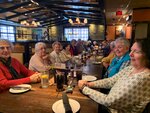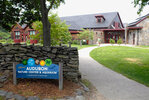Tri-County Regional Return To School Plan September 2020-Executive Summary
There were two key factors from our feasibility study that played a part in our planning and decision making for the re-opening. Through our parent survey comments, we realized the first key factor was the primary emphasis for in–person learning needed to be on our vocational program. Our parents felt that the reason their student attended our school was because of the technical education we offer. It is what differentiates us from their local school district. Our practice of alternating weeks for vocational and academic instruction, with underclassmen and upperclassmen assigned to each, provides a natural cohort model for our vocational and academic programs.
The second key factor was transportation. The district has a large geographical footprint that measures 25 plus miles from the towns of Seekonk to Millis and east to Walpole. Under current transportation capacity guidelines and utilizing our present number of buses, we will be able to transport 391 students. In order to transport more students each day we would need to look at adding more bus runs. It would be very difficult for us to stagger bus transportation, as many of our bus runs take upwards of an hour to and from school.
Considering these two key factors, we feel that the best plan for us would be a Hybrid phased reopening with one grade level of students attending their vocational program each day and all academic instruction remote. Each grade level is about 250 students. We would provide in-person vocational instruction two and one half days for underclassmen and two days for upperclassmen each week. On the other two days for underclassmen and two and one half days for upperclassmen students would receive remote vocational instruction. Under Phase I we would run this schedule for one A week (grades 9 & 11) and one B week (grades 10 & 12) cycle in their vocational program. This would provide live instruction to 25% of our total student enrollment. If the logistics and safety protocols work out, we would expand this to Phase II with both grades in a particular vocational program attending together or 50% of our total enrollment. Under Phase I and II, vocational in-person instruction only, there would be no passing in the corridors and students would eat lunch in their shops, eliminating the need for students to pass in the corridors.
In order for us to consider in person academic instruction under the Hybrid Phased Reopening Plan, we felt we needed to develop a six-foot (Phase III) and a three-foot (Phase IV) model to have flexible options in dealing with passing between classes and lunch in the cafeteria. To ensure minimal class sizes, under the six-foot model, students would be grouped into cohorts according to last name. On B week, Mondays and Thursdays 9/11th graders with last names A – N will be in the building for instruction, while last names O – Z work remotely. On Tuesdays and Fridays, they will switch modes of instruction. On A week the same pattern holds true for 10/12th graders in academics. On Wednesdays, all students work remotely, while staff is in the building.
In the three-foot model, on Mondays, Wednesdays, and Fridays 9th graders will receive in-person instruction while 11th graders are working remotely. On Tuesdays and Thursdays 11th graders will receive in-person instruction while 9th graders are working remotely. On A weeks the same pattern will hold true for 10/12th graders in academics. Wednesdays will follow the one-half day in-person schedule.
In all of these hybrid models a robust remote learning plan is a must. The remote learning model for academic instruction follows a condensed version of the daily schedule with time allotted every morning for teacher common planning and time at the end of the day for office hours. Each of the five periods will start on the hour and will be forty minutes long with twenty minutes in between for student personal time. Wednesdays will still follow the ½ day schedule. Attendance will be taken daily at the beginning of each period. Staff will conduct a minimum of two synchronous learning activities per class per week while providing asynchronous activities on the remainder of the days. Multiple technologies will be utilized including but not limited to the ItsLearning platform, PowerSchool, Google Suite, Zoom, and a variety of other content-specific tools. Students will be expected to adhere to all protocols and standards of behavior for Tri-County.
Each vocational class will meet synchronously with an instructor via video meeting every morning under the remote plan. This is a mandatory whole class meeting to establish expectations for each day, and to provide opportunity to check-in and provide direct instruction of new material from the curriculum frameworks. Teachers will meet synchronously with small groups of students or individuals later in the day for check-ins. Both individual and small group meetings will be scheduled. Teachers will have a minimum of one week of material prepared for remote learning at all times. High standards and student engagement will be defined. Evidence of at least four hours of work per day from each student is required. Student work will be assessed. When possible kits of shop materials and equipment will be made available for students to take home, as needed. Teachers will have access to video recording equipment and professional development to develop content for asynchronous instruction. Staff will utilize office hours for increased family communication and provide timely and effective feedback to students and parents.
During remote learning, economically disadvantaged students are ensured nutritional assistance through their sending district. We will provide all students with Chromebooks and are actively working on providing hotspots to ensure that every Tri-County student has reliable internet access.
While the first two phases of reopening call for remote learning for academics, a small cohort of sub-separate students will attend school in-person along with designated vocational students with all safety protocols followed. In order to establish the cohort, we reviewed the IEPs of all students, and determined their need for significant intervention during both in-person instruction and remote learning.
Our goal is to safely get to Phase V, a 100% in-person model, that will require students to receive instruction full time in the school setting according to the three-feet distancing guidelines and will follow the traditional school schedule of week on/week off. All students will be issued their own Chromebook. We have built a half-day at mid-week for students to allow for the implementation of extensive cleaning protocols, as well as professional development opportunities and collaboration time for faculty and staff. We have removed excess furniture from the academic classrooms to accommodate a 24-student maximum. On-site remote learning labs will be utilized for classes that exceed the 24-student maximum and to address students who are unable to attend school.
Counseling needs will be addressed by counselors remotely or in person as appropriate to phasing for existing caseload students as well as new wellness referrals. Students with 504 plans will have accommodations ensured by guidance counselors.
Incoming and existing EL and FEL students will have their progress and proficiency levels assessed at the start of the school year to determine appropriate direct services and monitoring with our EL specialist. Important family outreach will be translated for language needs.
We have increased passing times between classes as well as during lunch to facilitate one-way traffic in the hallways and appropriate sanitation protocols. The start and end of the day have been adjusted to stagger arrivals and dismissals.
We believe that our Hybrid Phased Reopening Plan will provide the confidence and knowledge of the required protocols to safely allow 100% in-person instruction at some point in time this school year.
Complete “Return to School Plan September 2020” (PDF)


















Comments
No comments on this item Please log in to comment by clicking here